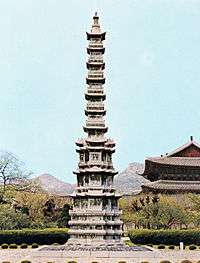Korean pagoda
Korean pagodas are a traditional Korean architectural form that began in the Three Kingdoms of Korea period. Koreans created a unique and distinct pagoda tradition using stone.[1][2][3]
 |
| Part of a series on the |
| Culture of Korea |
|---|
| History |
|
Festivals |
|
|
Music and performing arts |
|
Media
|
|
|
Monuments
|
|
National symbols of Korea
|
History
Pagodas were created in India using earth, then in China using wood, which spread to the Three Kingdoms of Korea, and then Japan; however, the pagoda tradition of East Asia diverged, with China creating pagodas using bricks, Korea creating pagodas using stone, and Japan continuing to use wood.[4][5][6][7][8]
Korean stone pagodas were first created in Baekje during the early 7th century and then inherited by Later Silla; 90% of the pagodas in Later Silla were made of stone.[4] The stone pagoda tradition was propagated by the great abundance of high quality granite in Korea,[9] which also led to other granite creations such as the Seokguram and Cheomseongdae. Goryeo, a devoutly Buddhist state, also inherited the stone pagoda tradition.[10]
Examples of Korean wood pagodas are the Hwangnyongsa Pagoda and Palsangjeon of Silla.
Gallery

.jpg)
 Wongaksa Pagoda
Wongaksa Pagoda
top portion missing
 Bunhwangsa Pagoda
Bunhwangsa Pagoda
originally 9 stories tall
References
- The Korean Overseas Information Service Seoul, Republic of Korea (ROK). HELLO from Korea. 길잡이미디어. p. 52. ISBN 9788973753741. Retrieved 6 October 2016.
- Yu, Chai-Shin. The New History of Korean Civilization. iUniverse. p. xii. ISBN 9781462055616. Retrieved 6 October 2016.
- "pagoda | architecture". Encyclopædia Britannica. Retrieved 6 October 2016.
- Yu, Hong-jun. Smiles of the Baby Buddha: Appreciating the Cultural Heritage of Ky?ngju. 창비 Changbi Publishers. pp. 26–28. ISBN 9788936470562. Retrieved 6 October 2016.
- Sinha, P. C. Encyclopaedia of South East and Far East Asia. Anmol Publications. p. 2368. ISBN 9788126126460. Retrieved 6 October 2016.
Going from China to Korea and from Korea to Japan, the pagoda evolved in varying styles and materials: brick pagodas were more numerous in China, stone pagodas fairly soon predominated in Korea, and wooden pagodas were most popular in Japan.
- "Korea Journal". 17. Korean National Commission for UNESCO. 1 January 1977. Retrieved 6 October 2016. Cite journal requires
|journal=(help) - Koehler, Robert. Religion in Korea: Harmony and Coexistence. Seoul Selection. ISBN 9781624120459. Retrieved 6 October 2016.
- Korea (South) Munhwa Kongbobu (1970). The Ancient Arts of Korea. Ministry of Culture and Information. p. 73. Retrieved 6 October 2016.
Unlike the Chinese brick pagodas, the Silla people used granite stones in building the base of brick pagodas, probably due to the fact that the Silla people were more skilled in the technique of cutting stones, and quality granite is abundant in the Korean peninsula.
- Sinha, P. C. Encyclopaedia of South East and Far East Asia. Anmol Publications. p. 2368. ISBN 9788126126460. Retrieved 6 October 2016.
- Jinyoung, Lim; Lyong, Ryoo Seong. K-architecture: Tradition Meets Modernity. 길잡이미디어. pp. 35–36. ISBN 9788973755820. Retrieved 6 October 2016.